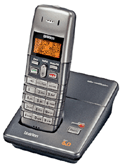I was having lunch with some of my previous work associates yesterday. We got to talking about mobile phones, the “bricks” of yesterday and the “razor” thin ones of today, and also about VoIP services (since half of us had it). This reminded me, since I’d read it sometime ago, but no longer remember who exactly coined it, that in the past, there were 3 ways to get information into your home:
- the phone line (which was bi-directional),
- over-the-air broadcast (one way) radio and
- broadcast TV
- well, maybe 4 if you count the newspaper or a magazine
Today, we still may have
- a phone line,
- the radio
- plus possibly also satellite radio
- broadcast TV may be completely replaced
- via cable (or satellite)
- but also there is a high-speed digital line that may be DSL (with the phone) or might come over the cable (with the cable TV)
- plus, in some areas optical fiber for the TV.
- Now we also have mobile cellular telephone service that's more or less been for voice,
- but is also increasing being used for data as the bandwidth increases (this is where I’m working in the industry now)
- A few years ago there where smatterings, then rivers, now floods of WiFi and now WiMAX, or metro broadband wireless (there used to be a company just down the street that was heavily involved in just this thing in South America, because it’s cheaper to “wire” households up this way than with copper).
- There are plenty more fixed and mobile communications options than I can think of right now. My sisters, in rural Minnesota, get a slower speed version of broadband that’s built off antennas on top of granary elevators and mini-pizzabox sized antenna’s on their houses or in their yards. The distribution antenna works for distances up to 15-20 miles. That and power are the reasons why it’s slower speed. This was put in place because the local telco switch was running out of ports for dial-up and basic voice, back 10-15 years ago, and an enterprising young man saw an opportunity and worked it, when the REA type telco couldn’t possibly move fast enough.
- And there's a chance you're still getting a newspaper delivered, too.
The point is, the source of bandwidth pretty much does not matter any more. You'll get your telephone service from somewhere in a network cloud, or maybe from some other network cloud if you move around. If you’re like me, you have application services that tie the endpoints together so that people calling you in one cloud don’t know that you’re answering in the other cloud.
This is largely going to be the same for your TV service. Our soldiers in Iraq, I’m told, have versions of IPTV that are more modern versions of the "triple play" that interworking of the broadband/phone/TV service, which is of course, carried on a military backbone or perhaps a leased facility back to their families here in the states. I don’t begrudge them a bit for a service such as this, but it sure heralds the future for us, doesn’t it?
Content is changing, too, newspapers are still around, but increasingly they have to pay attention to the online world. Oh, the basics of reporting and fact gathering is still largely the same, the tools are different and faster to use. Just lots more amateurs out there…
Radio, and now TV, are putting broadcasts (with and without commercials) out there for distribution via RSS or maybe forcing the website experience. Some media outlets are not getting “it” trying to force users to watch live (Nielson still has clout) in order to keep the same old revenue sources. Others ARE getting it, and that’s why there are DVD’s of whole season of TV shows, or in some forward looking markets, downloads or even feeds of shows. So, distribution models change and with it, the revenue dynamics. I freely admit I don’t have time to listen to that radio or TV show anymore in “real-time”. I want my “time-shifting” rights! So, podcasts and TiVo/MythTV – I think these are good things. Once bitten, “don’t take my TiVo away!”
In the future, it really won't matter if the pipe is
- FIOS (Fiber to the curb ala Verizon landline or my Dad’s cable company in rural MN),
- EVDO Rev. A (VerizonWireless and Sprint),
- HFC (CATV company), or
- copper wires (traditional telco).
Telco infrastructure is getting to the point where we don’t care what it is, as long as it’s there when we want it and it’s economical enough to fit into our lives without making us think about it. Content and basic service models are increasingly looking for alternative revenue sources, rather than the basic Alfred Hitchcock “word from our sponsor” model which really just shifts costs from minutes of use (MOU) into a bundled cost of an advertised product. MOU will still be there for a while, thanks to the telcos and more importantly, the mobile phone era. But something better than the current draconian measures envisioned with DRM and lawsuits is needed.
We’ve come a long way since when I would travel and my mother used to ask me to call collect and ask for Uncle Arvin, who was never there; it was just a pre-arranged signal that I had arrived at my destination. Let’s hope the coming years see as much of a change for the better as the last few years.
Happy Holidays.





